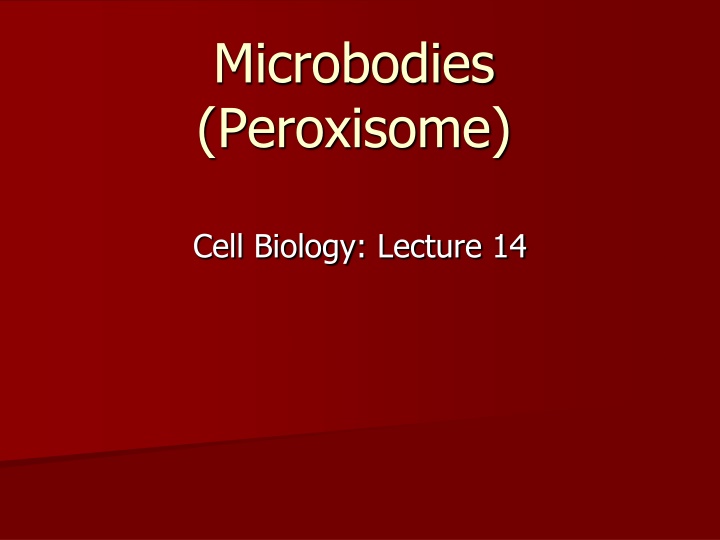
Peroxisomes and Glyoxysomes in Cell Biology
Explore the structures and functions of microbodies such as peroxisomes and glyoxysomes, essential organelles involved in metabolic processes including fatty acid oxidation and sugar synthesis. Discover the unique roles they play in cell biology.
Download Presentation

Please find below an Image/Link to download the presentation.
The content on the website is provided AS IS for your information and personal use only. It may not be sold, licensed, or shared on other websites without obtaining consent from the author. If you encounter any issues during the download, it is possible that the publisher has removed the file from their server.
You are allowed to download the files provided on this website for personal or commercial use, subject to the condition that they are used lawfully. All files are the property of their respective owners.
The content on the website is provided AS IS for your information and personal use only. It may not be sold, licensed, or shared on other websites without obtaining consent from the author.
E N D
Presentation Transcript
Microbodies (Peroxisome) Cell Biology: Lecture 14
Structure A crystalline structure inside a sac which also contains gray material Bound by a single membrane that separates their contents from the cytosol (the internal fluid of the cell) and contain membrane proteins critical for various functions
Peroxisomes (microbodies) are simple, membrane-bound vesicle with a diameter of 0.1 to 1.0 um. Peroxisomes are multifunctional organelles, containing more than 50 enzymes involved in such diverse activities as the oxidation of very-long-chain fatty acids (VLCFAs) and the synthesis of plasmalogens.
Plasmalogen a type of ether phospholipid Plasmalogens are found in numerous human tissues, with particular enrichment in the nervous, immune, and cardiovascular system.
Function They participate in the metabolism of fatty acids and many other metabolites. Peroxisomes harbor enzymes that rid the cell of toxic peroxides. Import proteins into the organelles and aid in proliferation. Peroxisomes can replicate by enlarging and then dividing. Peroxisomes also play a role in the production of bile acids and proteins.
Microbodies (Glyoxysomes)
specialized peroxisomes found in plants (particularly in the fat storage tissues of germinating seeds) and also in filamentous fungi in glyoxysomes the fatty acids are hydrolyzed to acetyl-CoA by peroxisomal -oxidation enzymes. Glyoxysomes also participate in photorespiration and nitrogen metabolism in root nodules.
contain enzymes that initiate the breakdown of fatty acids and additionally possess the enzymes to produce intermediate products for the synthesis of sugars by gluconeogenesis. glyoxysomes possess additionally the key enzymes of glyoxylate cycle (isocitrate lyase and malate synthase) which accomplish the glyoxylate cycle bypass.
Glyoxylate cycle The glyoxylate cycle results in the net conversion of two acetyl-CoA to succinate instead of CO2in citric acid cycle. Succinate is transferred to mitochondrion where it can be converted to OAA (TCA) Can go to cytosol where it is converted to oxaloacetate for gluconeogenesis
Gluconeogenesis Gluconeogenesis (GNG) is a metabolic pathway that results in the generation of glucose from non-carbohydrate carbon substrates such as pyruvate, lactate, glycerol, and glucogenic amino acids.
Definition: A vacuole is a large compartment filled with fluid that is in the cytoplasm of plants cells and animal cells. A Vacuole is a storage place for sugars, minerals, proteins, and water. Vacuoles also store and help carry out waste from the cell. The vacuoles also increase the size of the surface area of the cell: This allows the absorption of minerals that are necessary for plant and animal nutrition.
Vacuoles are filled up with a liquid called Cell Sap Cell sap contains the components of water, salt and sugar Vacuoles are not a part of the endomembrane system because they do not communicate with other organelles.
General Information: They enable the cell to change shape. They help the cell maintain its internal pH They help isolate materials that might be harmful or a threat to the cell. They help the cell maintain internal hydrostatic pressure.
Structure Vacuoles are organelles found in cells. They store various substances essential to the life of the cell. They also store waste to later remove from the cell.
Plant Cells Vacuoles make up about 80% of the volume of a full grown plant cell (source 4) They are more important in plant cells than any other types of cells They are surrounded by a membrane called a tonoplast They store water and food for the plants to use for other processes They store waste products of the cell
They store waste products of the cell They are called central vacuoles because their function is vital to the plant s survival and because they are so large The greater amount of water the vacuole holds, the more turgor pressure there is. Turgor pressure increases when there is more sugar and other solutes in the vacuole. This is because the increase of the solutes causes a need for more water, in which they can be dissolved. Turgor pressure is applied to the cell wall and therefore makes the plant rigid, keeping its structure. When central vacuoles lack water, the plant droops
Flower petals central vacuoles can contain substances that attract pollinating insects or repel harmful animals or organisms Osmoregulation- maintains osmotic pressure Vacuoles push cytoplasm toward the cell membrane, exposing chloroplasts to light
Animal Cells Misconception: Some people, to make things simple, say that animal cells do have vacuoles but animal cells do not have vacuoles. Instead, they contain vacuole-like organelles called vesicles Vesicles: similar function as vacuoles but much smaller than a plant s central vacuole Vesicles perform 2 important functions: Exocytosis: disposal of solids and liquids such as proteins, lipids and bacteria out of cells Endocytosis: taking solids and liquids such as proteins, lipids and bacteria into cells One cell can have multiple vesicles
Fungi Cells Fungal cell vacuoles perform many functions, similar to plant cell vacuoles They help remove waste product from the rest of the cell They help maintain the cell s pH levels so that it can function optimally Can have multiple vacuoles Osmoregulation- maintains osmotic pressure Stores amino acids
Conclusion Vacuoles are most important in plant cells Vacuoles have a similar function in fungal cells as plant cells Contractile vacuoles are found in protists and are most important in fresh water organisms Vacuoles are important for storage in cells Vacuoles collect harmful waste and dispose of it Animal cells have vesicles, not vacuoles



![Lec [2] Health promotion](/thumb/274962/lec-2-health-promotion-powerpoint-ppt-presentation.jpg)